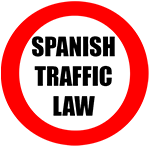1. It is prohibited to stop:
A) On curves and slopes with reduced visibility, in the vicinity of these and inside tunnels, underpasses and sections of roads affected by the sign «Tunnel».
B) On level crossings, cycle crossings and pedestrian crossings.
C) On lanes or parts of lanes reserved exclusively for movement or for certain users only.
D) At intersections and in their vicinity if it makes turning difficult for other vehicles, or on interurban roads if danger is generated due to lack of visibility.
E) On tram tracks or close enough to them that movement can be obstructed.
F) In the places where the visibility of signs is impeded to other road users and it affects them or forces them to make manoeuvres.
Vans, Caravans … sometimes because of their large size, they hide important signs for other road users, and in these instances they should seek another parking space.
G) On motorways, except in the areas authorised for this purpose.
There are cases of drivers on motorways, who receive a phone call and, as they cannot talk on the phone while driving, park their vehicle on the hard shoulder to answer the call.
The hard shoulder is only to be used for emergency reasons and a phone call, no matter how important, is not a reason to stop on the motorway. You must leave at the first exit or look for a rest area where you can do it safely.
People do not realise that every year there are collisions that, due to the driver being distracted, vehicles drift onto the hard shoulder and hit other vehicles that were pulled up there. We must be aware that the use of the hard shoulder is only for vehicle emergencies and passengers who cannot wait to find a safe place.
H) In lanes destined to the exclusive use of urban public transport, or in the lanes reserved for bicycles.
I) In the areas designated for parking and exclusive use of public transport stops.

J) In marked areas for the exclusive use of disabled people and steps for pedestrians (article 39.1 of the articulated text).
2. It is prohibited to park in the following cases:
A) In all those described in the previous section in which stopping is prohibited.

B) In the places authorised by the municipal authority as parking with time limitation without placing the ticket that authorises it, or when the ticket is placed the vehicle is parked in excess of the maximum time allowed by the municipal ordinance.

C) In areas marked for loading and unloading.

Parking is prohibited from times specified, except Loading and Unloading;
It is forbidden to park during the time period and days specified, since these hours are reserved only for vehicles that are going to load and unload merchandise. The sign may indicate hours, days, or a combination of factors. Outside these hours it may be used by everyone.
Prohibited parking. Except Loading and Unloading from times specified;
It is forbidden to park EVERY day, only with an exception from the times specified, for loading and unloading vehicles.
D) In designated areas for the exclusive use of disabled persons.
E) On pavements, promenades and other areas intended for pedestrians.

F) In front of correctly marked access points.

When you pay for a Vado you are paying for having free access to your garage, driveway or building, not for a free parking space on a public road.
Keep Clear Sign; issued by the appropriate Town Hall, with an assigned number shown on the sign.
Some people buy Keep Clear or No Parking signs at a hardware store and put them in front of their garages. These signs are not valid if they are used as a Keep Clear sign or to prohibit parking on the public road since the Town Hall regulates this and has authority for parking regulations in the city.
Remember that when you pay for a Keep Clear sign, you are paying to have the right to access and egress your garage, not a parking space on public roads. Some people think that they can park their vehicle at the door of their garage, just where it is no parking to access the drive, because they have a Keep Clear sign. Then when they are fined they realise that the Keep Clear sign only gives them access to the garage.
G) In double row (article 39.2 of the articulated text).

3. Stopping or parking in the places listed in paragraphs a), d), e), f), g) and i) of section 1, in the level crossings and in the lanes designated for the use of urban public transport will have the consideration of serious infractions, as foreseen in article 65.4.d) of the articulated text.
Note that the reference to article 65.4.c) should be understood as referring to article 65.4.a), as established in the third final provision of this Regulation, introduced by section ten of the single article of the R.D. 965/2006, of September 1, by which the General Regulation of Circulation is modified, approved by R.D. 1428/2003, of November 21 (“B.O.E.” September 5).














